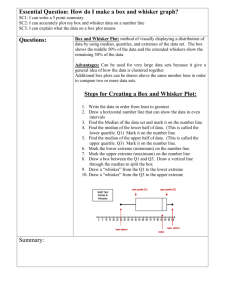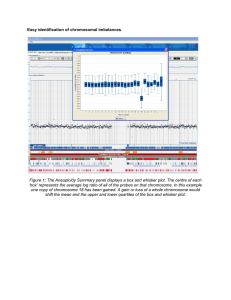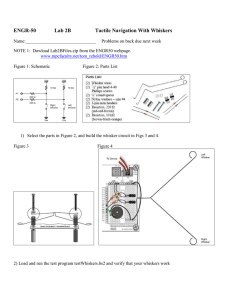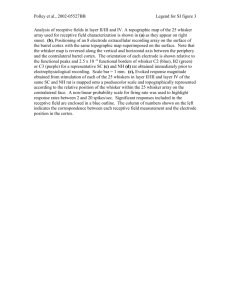Sn Whisker Growth Propensity of Pulse
advertisement
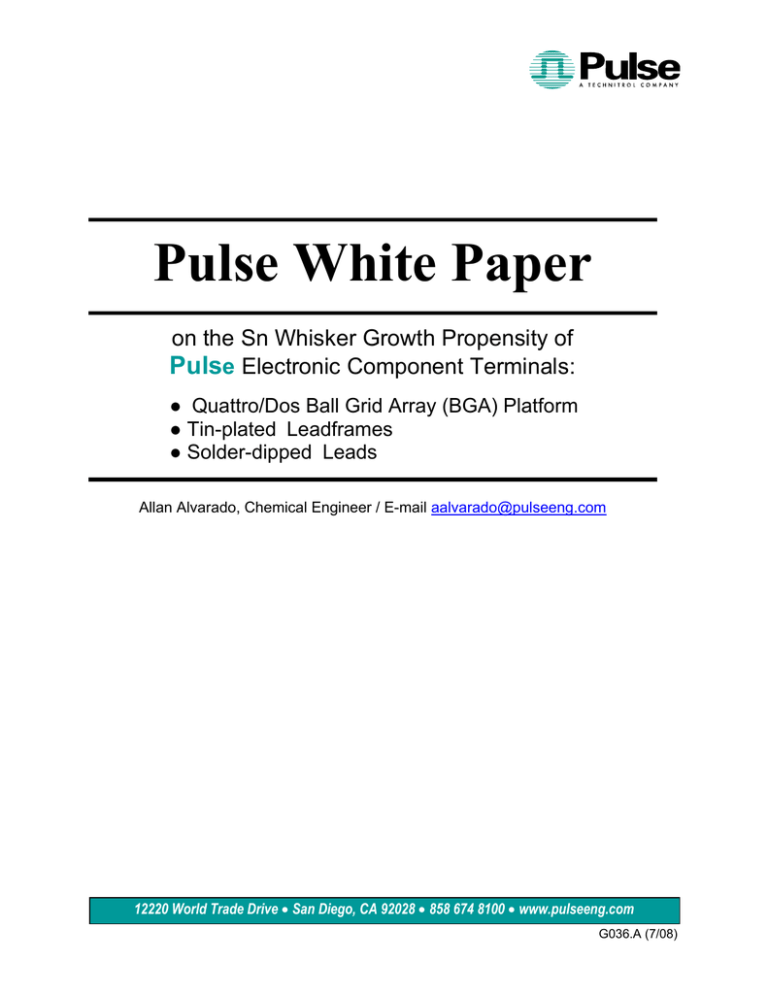
Pulse White Paper on the Sn Whisker Growth Propensity of Pulse Electronic Component Terminals: ● Quattro/Dos Ball Grid Array (BGA) Platform ● Tin-plated Leadframes ● Solder-dipped Leads Allan Alvarado, Chemical Engineer / E-mail aalvarado@pulseeng.com 12220 World Trade Drive • San Diego, CA 92028 • 858 674 8100 • www.pulseeng.com G036.A (7/08) Sn Whisker Growth Propensity of Pulse Electronic Component Terminals Table of Contents I. INTRODUCTION......................................................................................................... 1 II. BACKGROUND........................................................................................................... 1 SOURCES OF COMPRESSIVE STRESSES ............................................................. 1 A. Intermetallic Compound Growth..................................................................... 2 B. Stress Induced by Mismatching Coefficients of Thermal Expansion .............. 2 C. Applied Mechanical Stress............................................................................. 3 D. Additives and Impurities in Sn Layer.............................................................. 3 STRESS RELAXATION MECHANISMS ..................................................................... 3 A. Sn Layer Thickness........................................................................................ 4 B. Sn Grain Morphology ..................................................................................... 4 C. Sn Oxide Layer and Surface Imperfections.................................................... 4 III. TIN MITIGATION MITIGATION MEASURES............................................................. 4 A. Minimal Sn Overplating Layer Thickness ....................................................... 5 B. Ni Underplating Barrier Layer......................................................................... 5 C. Sn Grain Size................................................................................................. 5 D. SAC Alloy Solder ........................................................................................... 5 IV. PULSE COMPONENT PLATFORMS ........................................................................ 5 A. Tin Plated Leadframes ................................................................................... 6 B. Sn Dipped Leads............................................................................................ 6 C. Quattro/Dos Ball Grid Array Platform ............................................................. 7 V. SUMMARY ................................................................................................................. 8 References...................................................................................................................... 9 12220 World Trade Drive • San Diego, CA 92028 • 858 674 8100 • www.pulseeng.com G036.A (7/08) Sn Whisker Growth Propensity of Pulse Electronic Component Terminals I. INTRODUCTION World wide environmental regulations have required electronics manufacturers to adopt lead-free and environmentally friendly processes and materials in the construction of their components. Until the recent enactment of the EU and China reduction of hazardous materials (RoHS) legislations, the use of lead used in solders to make internal connections and lead-frame platings was widespread. Pure Sn (tin) and Sn rich alloys and solders have become viable options due to their compatibility and relative low cost. The transition to these Pb-free materials has presented technical challenges and quality and reliability concerns. The major concern is that of the growth of Sn filaments or whiskers that have the potential to cause malfunctions by shorting electrical circuits. This was first observed in 1947. This paper will address the concerns Pulse customers have regarding the Sn whisker propensity of Sn plated and Sn dipped surface finishes. II. BACKGROUND There is much interest and ongoing research in Sn whisker growth, but due to the complexity and multiple contributing factors involved; there is no one single model that can describe the phenomenon entirely. Despite the differing opinions it is widely accepted that compressive forces drive Sn whisker formation. The forces responsible for Sn whisker growth can be grouped into two broad categories of factors: 1) The sources of the compressive stress and; 2) The mechanism by which the stress is relieved. The factors that contribute to the formation of compressive stresses are mechanical, thermal and chemical: 1) Formation of an intermetallic compound (ImC) Sn6Cu5. 2) Coefficient of thermal expansion (CTE) mismatch between the base metal substrate and the plating layer. 3) Induced mechanical stress. The factors that affect the manor in which the stress is released are: 1) Thickness of the Sn layer. 2) Sn grain morphology. 3) Thickness of the surface SnOx. 4) Surface imperfections. Both the stress sources and relief mechanism will be further discussed. SOURCES OF COMPRESSIVE STRESSES A. Intermetallic Compound Growth Leadframe base metal composition plays an important role in the components Sn whisker propensity. A commonly used alloy in leadframe construction is phosphor bronze. Phosphor bronze alloys composition is 60% Copper, 28% Zinc, 0.3% Phosphorus and other trace metals. At the base metal and plating layer interface, Copper is the primary diffusing species into Sn. Sn diffusion into Cu is negligible. The diffusion of Cu shown as upward arrows in Fig. 1 from the Cualloy substrate into the Sn layer forms two inter-metallic compounds, Sn6Cu5 and Cu3Sn at the Cu-Sn boundary as shown in Fig. 1. Lower initial thermal conditions kinetically favor the formation of over Sn6Cu5 over Cu3Sn. Sn6Cu5 has a lower density than Cu3Sn and the surrounding Sn. At ambient temperature Sn6Cu5 is the preferred crystal and has a scallop 12220 W 12220 World Trade Drive • San Diego, CA 92028 • 858 674 8100 • www.pulseeng.com 1 G036.A (7/08) Sn Whisker Growth Propensity of Pulse Electronic Component Terminals morphology. This type of structure occupies a greater Molar volume than the Cu3Sn, which form a layer structure and the Sn it displaces, thus exerts compressive forces shown are horizontal arrows in Fig. 1 upon the Sn overplating. The system relieves these stresses by the protrusion of a Sn whisker at the Sn grain boundary on the surface. Fig 1. Schematic diagram of the layered Sn-Cu alloy structure of a barrier-less lead-frame. ImC compressive stress plays a prominent role in copper rich alloys, such as phosphor bronzes. Phosphor bronze based leadframes are thus prone to Sn whisker if left unmitigated. B. Stress Induced by Mismatching Coefficients of Thermal Expansion Another common but less used material in leadframe construction is Alloy 42. This alloy contains 42% Nickel and the remainder Iron with traces amounts of 0.2% Silicon and 0.4% Manganese. During thermal cycling, the Sn layer experiences tensile and compressive forces. Due to differences CTE’s the metal substrate will prevent the Sn layer from expanding. This will generate compressive stress on Sn layer. Alloy 42 leadframes are not susceptible to ImC growth, but are more sensitive to dimensional distortions due differences in CTE’s and in turn produce compressive stress, as shown in Fig. 2 below. This difference in CTE’s is shown by the red arrows. Phosphor bronze alloys will also experience compressive stress in addition to that imparted by -6 growth of an ImC. Sn and Alloy 42 have corresponding CTE values of 22.0×10 /ºC and 4.0 -4.3 -6 ×10 /ºC. It is difficult to find agreeing values for CTE’s for ImC’s in the literature due to the difficulty in obtaining homogeneous samples in sufficient quantities for testing. Therefore values have been omitted. For these reasons Sn-Alloy 42 systems are benign to Sn whiskering if temperature cycling and storage conditions are kept to a minimum and close to ambient temperature. 12220 W 12220 World Trade Drive • San Diego, CA 92028 • 858 674 8100 • www.pulseeng.com 2 G036.A (7/08) Sn Whisker Growth Propensity of Pulse Electronic Component Terminals Fig 2. Schematic diagram of the layered Sn-Alloy 42 structure of a barrier-less lead-frame. C. Applied Mechanical Stress The bending, twisting and clamping forces applied to the leadframe during manufacture, assembly of product and normal operating conditions will produce compressive stresses at the point of contact and also in bends and joints. This is a concern, but to a lesser degree than the previous mentioned ones. D. Additives and Impurities in Sn Layer Certain metals intentionally added or present as impurities can decrease the Sn whisker propensity by lowering the CTE of the alloy or increase it if they readily oxidize and increase compressive stresses. The presence of copper in the SAC alloy has the effect of lowering the CTE of tin from ~22 to -6 ~14×10 /ºC, while forming a barrier between the tin plates. Some rare earth elements such as Cerium and Lutetium present in trace amounts have been reported to cause extensive whiskering since they readily oxidize and increase compressive stresses. It has been reported that the carbon content of the plating solution is a factor. It is believed that the plating solution used to electro-deposit the Sn grains comprising the Sn layer will form finer grains with increasing carbon concentration. There is some controversy as it is also possible to make fine Sn grains with low carbon content solutions. STRESS RELAXATION MECHANISMS Stress relaxation factors play a key role in the whisker surface density, length and morphology of the Sn whisker. Whiskers have been reported to grow as much as a few hundred micrometers with an approximate diameter of three micrometers. The stress relaxation factors are further described. 12220 W 12220 World Trade Drive • San Diego, CA 92028 • 858 674 8100 • www.pulseeng.com 3 G036.A (7/08) Sn Whisker Growth Propensity of Pulse Electronic Component Terminals A. Sn Layer Thickness Sn whisker surface density is inversely proportional to the thickness of the Sn layer. More whiskers are found on thin finishes than thicker ones. The reason is compressive stresses propagate and remain more focused to the surface from the ImC layer thru shorter distances. Thicker finishes typically have increased wetability problems so there is an optimum layer thickness between 5-10 µm. B. Sn Grain Morphology As the name implies, Sn whiskers are long filaments protruding from the plating surface. Sn whiskers can also be irregular or nodular in appearance as shown in Fig 3. This type of whisker is called the hillock-type. The length of the Sn whisker is believed to depend on the morphology and orientation of the Sn grain from which it emerges. It has been observed that rougher larger Sn grains (matte) will produce hillock-type whiskers and smaller (bright) grain finishes will produce filaments. A possible explanation is that compressive stress is partially countered by tensile stress generated by bulk diffusion of Cu thru the larger voids in between larger grain sizes. Filaments will erupt from ternary grain boundaries while hillocks will erupt from entire grains. Fig 3. Schematic diagram of the layered Sn-Cu alloy structure of a barrier-less lead-frame. C. Sn Oxide Layer and Surface Imperfections Sn platted surfaces readily form an oxide layer, SnOx. The presence of this layer is critical for whisker formation. This layer acts as a barrier that prevents a vacancy gradient flux from being established that originates from the surface down to the ImC layer. Sn creep induced by compression to the surface thru these vacancies is blocked and compressive stress builds and will eventually cause a whisker to erupt wherever there is a weak spot. Metals such Cu and Fe that do not form oxide layer have not been reported to whisker. 12220 W 12220 World Trade Drive • San Diego, CA 92028 • 858 674 8100 • www.pulseeng.com 4 G036.A (7/08) Sn Whisker Growth Propensity of Pulse Electronic Component Terminals III. TIN WHISKER MITIGATION MEASURES Scientists, engineers and researchers from eight leading manufacturers of electronics goods have formed a consortium called the international Electronics Manufacturing Initiative (iNEMI) Tin Whisker Group. This group’s task is to make recommendations on Pb-free finishes. Pulse has adopted the Tin whisker mitigation recommendations made by the iNemi. These accepted mitigation measures are detailed in the following section. A. Minimal Sn Overplating Layer Thickness A minimal 2µm thick Sn layer is recommended for Ni barrier containing finishes. An 8µm thick layer is recommended for barrier-less finishes. B. Ni Underplating Barrier Layer The addition of an underplating layer decreases the compressive stress upon the overplated Sn layer by blocking the diffusion of Cu and the formation of ImC’s, thus mitigating Sn whisker formation. There is a second mechanism by which Ni underplatings mitigate Sn whisker formation. The Sn in the overplating layer diffuses into Ni to form the intermetallic Ni3Sn4. This leaves vacancies in the Sn layer that that establish tensile stress. C. Sn Grain Size As has been previously mentioned, large Sn grains (matte) in the size range of 1-5µm will form hillock-type protrusions on the Sn surface layer as opposed to filaments. Matte Sn finishes are the only type used. D. SAC Alloy Solder The addition of copper to the Sn3.5Ag0.5Cu (SAC) alloy has the effect of lowering the CTE of tin -6 from ~22 to ~14×10 /ºC, while forming an intra-grain ImC barrier that prevents further formation of Sn6Cu5 between the tin plates. A Sn0.7Cu alloy blend is also used. The eutectic SAC alloy is the preferred material used. IV. PULSE COMPONENT PLATFORMS Pulse manufactures a large variety of passive components. Many of them have been reengineered or converted over to be Pb-free RoHS compliant. The concern faced by Pulse customers is with the components containing these Pb-free materials. The impacted products are of three class types: Tin plated leadframes, Sn dipped leads and the Quattro/Dos ball grid array platform. The Sn whisker mitigation measure is unique to each family of components and will be further detailed in the following sections. 12220 W 12220 World Trade Drive • San Diego, CA 92028 • 858 674 8100 • www.pulseeng.com 5 G036.A (7/08) Sn Whisker Growth Propensity of Pulse Electronic Component Terminals A. Tin Plated Leadframes Fig 4. Schematic diagram of the layered Cu-Alloy structure of a Ni barrier containing lead-frame. B. Sn Dipped Leads Sn dipped copper wires are dipped into hot SAC and SnCu0.7 solders. The nominal thickness of this layer is 50µm. The thickness of this layer far exceeds the 8µm minimum recommended by the iNEMI Tin Whisker Group Fig 5. Schematic diagram of the layered Cu alloy/Sn dipped wire surface structure. 12220 W 12220 World Trade Drive • San Diego, CA 92028 • 858 674 8100 • www.pulseeng.com 6 G036.A (7/08) Sn Whisker Growth Propensity of Pulse Electronic Component Terminals C. Quattro/Dos Ball Grid Array Platform The solder ball on the Quattro/Dos Ball Grid Array Platform’s PCB is made from a SAC alloy paste. Each ball is ~760 µm in diameter as shown in Fig. 6. The spacing or pitch to the nearest neighboring solder ball is ~ 1221µm away as shown if Fig. 7. Fig 6. Schematic diagram of a solder ball of the Quattro/Dos BGA platform. The selection of a SAC alloy is an effective mitigation measure. Also since the ball pitch is greater than 500 µm it is not considered to be fine pitch. The size of the solder ball greatly exceeds the minimum 8µm thickness recommendation from the iNEMI Tin Whisker Group. HALT testing has also been performed on this platform has not failed due to Sn whisker growth. The strict quality control measures are in place ensure the purity of the paste use and that the material is free of any oxidizable metals that could cause Sn whiskering. Fig 7. Schematic diagram of the Quattro/Dos BGA PCB layout. The Quattro/Dos BGA platform is therefore effectively mitigated against Sn whiskers. The use of a SAC alloy has been deemed an effective mitigation measure also by the iNEMI Tin Whisker Group. 12220 W 12220 World Trade Drive • San Diego, CA 92028 • 858 674 8100 • www.pulseeng.com 7 G036.A (7/08) Sn Whisker Growth Propensity of Pulse Electronic Component Terminals V. SUMMARY Pulse maintains strict quality control measures to assure the purity of the materials used in the manufacture of our components. Pulse adheres to the iNemi consortia recommendations on Tin Whisker Mitigation recommendations, such as minimum plating thickness, Nickel Barrier layer, Matte Tin grains and use of low carbon content electroplating bath. Pulse believes the Ball Grid Array (BGA) platform of the Quattro/Dos product lines to be free or minimally affected by the forces that act to create Tin Whiskers. Pulse is currently performing Tin Whisker testing based on the industry standard JESD22A121 and expects to have reports available Q308. Please contact your sales representative for more information. Pulse continually researches new materials and technologies to further improve the quality and reliability of our components. Pulse believes the Sn whisker propensity if its components is effectively mitigated. 12220 W 12220 World Trade Drive • San Diego, CA 92028 • 858 674 8100 • www.pulseeng.com 8 G036.A (7/08) Sn Whisker Growth Propensity of Pulse Electronic Component Terminals REFERENCES [1] K.N. Tu, “Cu/Sn interfacial reactions: thin-film case versus bulk case” Materials Chemistry and Physics 46 (1996) 217-223. [2] iNEMI Tin Whisker Group Recommendations on Lead-Free Finishes for Components Used in High-Reliability Products Version 4 (12-1-06) [3] H.J. Kao, et al, “Effect of Cu Additives on Sn Whisker Formation of Sn(Cu) Finishes” Journal of Electronic Materials, Vol. 35, No. 10, 2006. [4] Tung-Han Chuang, Shiu-Fang Yen, “Abnormal Growth of Sn Whiskers in a Sn3Ag0.5Cu0.5C3 Solder Ball Grid Array Package” Journal of Electronic Materials, Vol. 35, No. 8, 2006. [5] Guh-Yaw Jang, et al, “Influence of Cu Content on Compound Formation near the Chip Side of the Flip-Chip Sn-3.0Ag-*0.5 or 1.5)Cu Solder Bump during Aging”, Journal of Electronic Materials, Vol. 35, No. 9, 2006. [6] Tung-Han Chuang, “Rapid whisker growth on the surface of Sn-3Ag-0.5Cu-1.0Ce solder joints”, Scripta Materialia 55 (2006) 983-986. [7] T.H. Chuang, “Rapid growth of Sn whiskers on the surface of Sn-6.6Lu alloy”, Scripta Materialia 56 (2007) 45-48. [8] Chen Xu, et al, “Driving force for the formation of Sn whiskers: Compressive stress – Pathways for its generation and remedies for its elimination and minimization” IEEE Transactions On Electronics Packaging Manufacturing. Vol 28, No. 1, Jan 2005. [9] Wan Zhang, et al, “Investigation of Sn-Cu intermetallic compounds by AFM: New aspects of the role of intermetallic compounds in whisker formation” IEEE Transactions On Electronics Packaging Manufacturing. Vol 28, No. 1, Jan 2005. [10] G.T. Galyon, et al, “An integrated theory of whisker formation: The physical metallurgy of whisker formation and the role of internal” IEEE Transactions On Electronics Packaging Manufacturing. Vol 28, No. 1, Jan 2005. [11] Sudarshan Lal, et al, “Role of intrinsic stresses in the phenomena of tin whiskers in electrical connectors”, IEEE Transactions On Electronics Packaging Manufacturing. Vol 28, No. 1, Jan 2005. [12] S.J. Wang, et al, “Kinetic analysis of the interfacial reactions in Ni/Sn/Cu sandwich structures”, Journal of Electronic Materials, Vol. 35, No. 11, 2006 [13] W.J. Choi, et al, “Tin whiskers studied by synchrotron radiation scanning x-ray microdiffraction”, Acta Materialia 51 (2003) 6253-6261 [14] K.S. Kim, et al, “Tin whisker formation of lead-free plated leadframes”, Microelectronics Reliability, Vol 46 (2006) 1080-1086 [15] Yuki Fukuda, et al, “The impact of electrical current, mechanical bending, and thermal annealing on tin whisker growth”, Microelectronics Reliability Vol 47, 2006, 88-92 [16] K.H. Prakash, et al, “Interface reaction between copper and molten tin-lead solders”, Acta Materialia, Vol 49, 2001, 2481-2489 [17] Kyung-Seob Kim, et al, “Behavior of tin whisker formation and growth on load-free solder finish”, Thin Solid Films, 504, 2006, 350-354 [18] Y. Zhang, et al, “An alternative surface finish for tin/lead solders: Pure tin”, Lucent Technologies Bell Laboratories, 12220 W 12220 World Trade Drive • San Diego, CA 92028 • 858 674 8100 • www.pulseeng.com 9 G036.A (7/08)

